CHCECE007: Analyzing Learning Environments for Children & Families
VerifiedAdded on 2023/06/12
|9
|2616
|86
Report
AI Summary
This report focuses on the importance of the learning environment and practices that honor the child, families, and local society. It addresses creating a supportive and inclusive learning environment, encouraging family and community involvement, and adhering to National Quality Standards and Early Years Learning Frameworks. The report also discusses strategies for guiding children's behavior, promoting self-regulation and self-esteem, and resolving conflicts. Key documents like the National Quality Standards, Early Years Learning Framework, and the United Nations Convention on the Rights of the Child are referenced to support best practices in early childhood education. The analysis emphasizes the importance of positive relationships, individualized learning, and respecting children's rights and choices in their development and learning experiences.
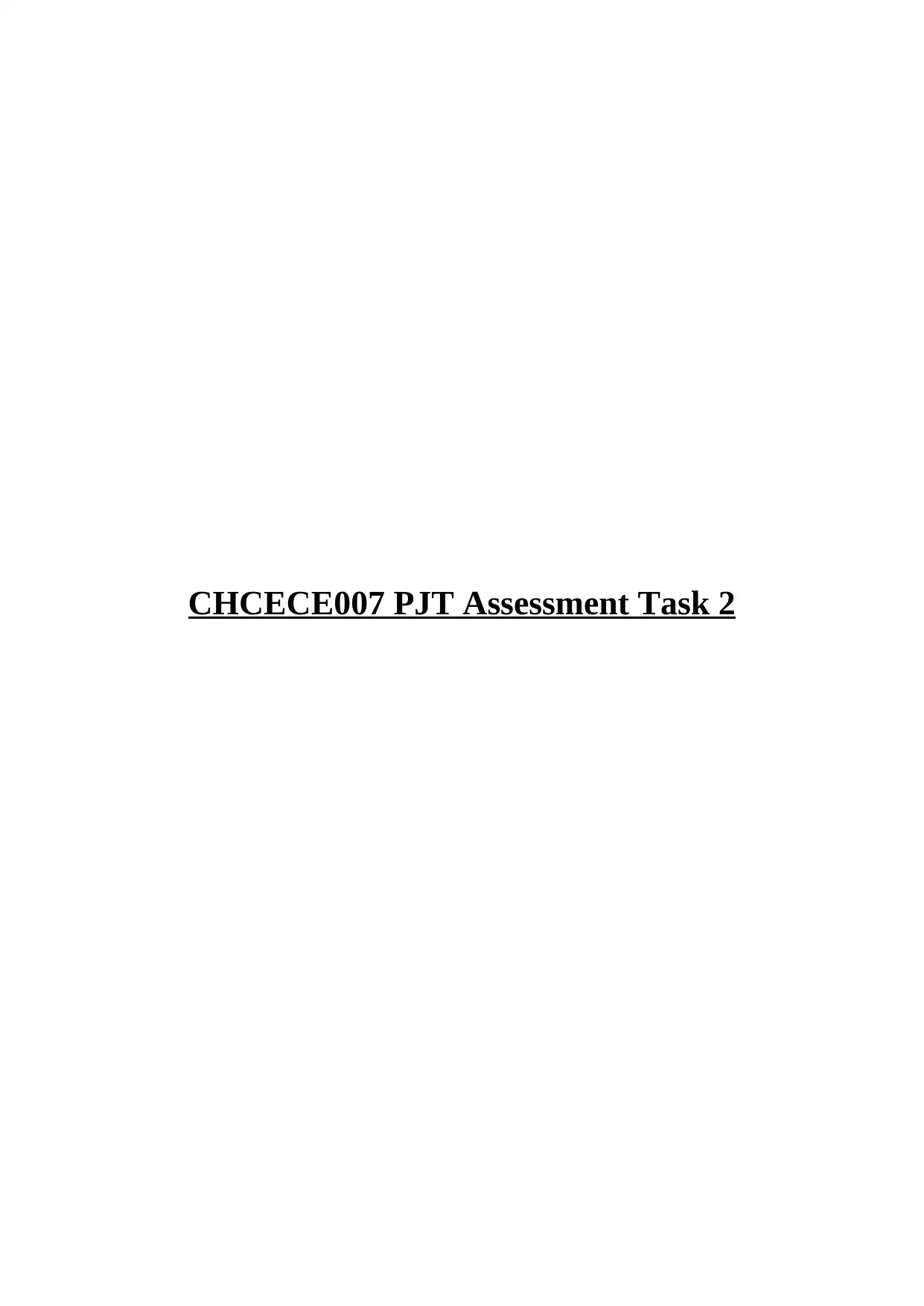
CHCECE007 PJT Assessment Task 2
Paraphrase This Document
Need a fresh take? Get an instant paraphrase of this document with our AI Paraphraser
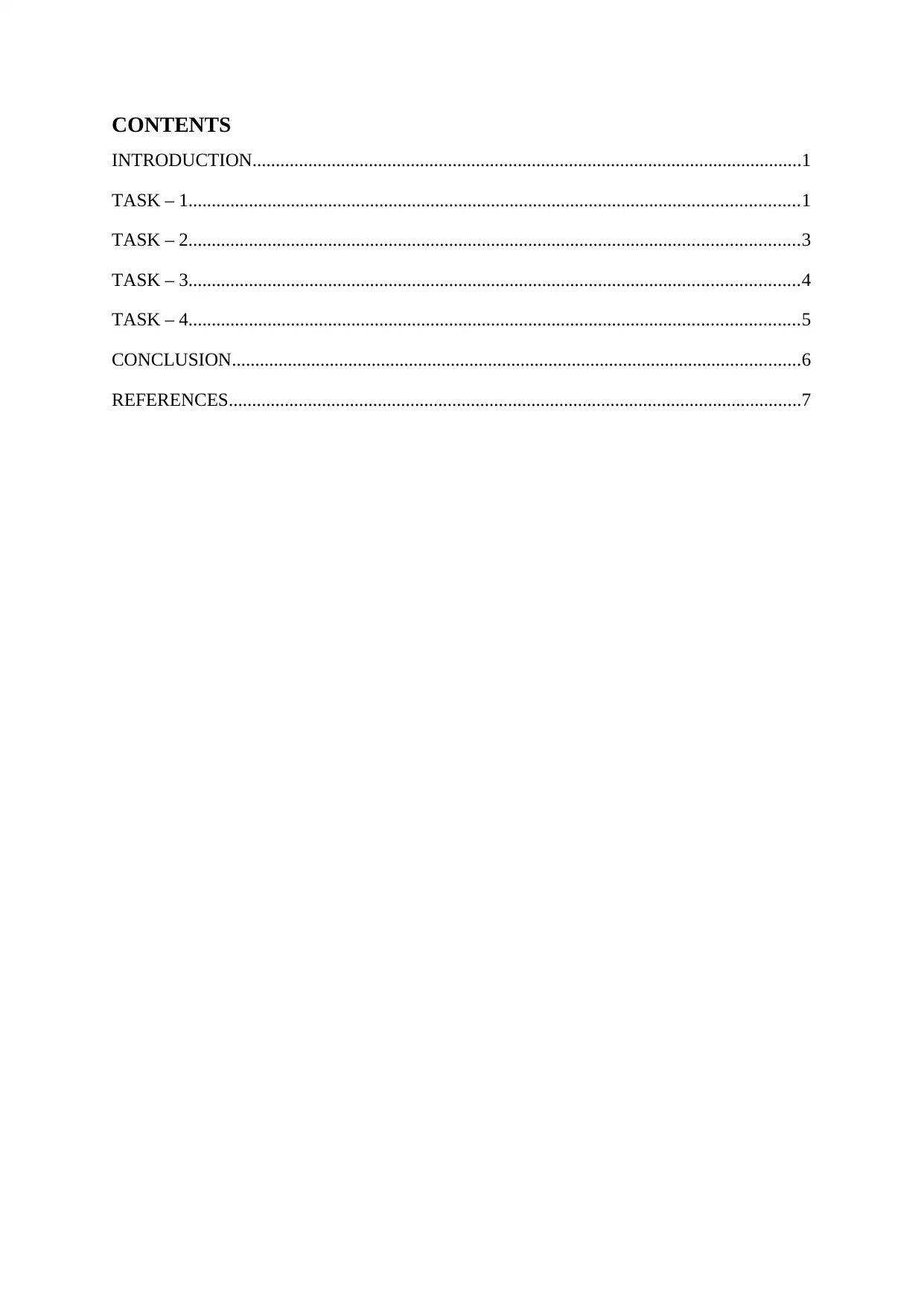
CONTENTS
INTRODUCTION......................................................................................................................1
TASK – 1...................................................................................................................................1
TASK – 2...................................................................................................................................3
TASK – 3...................................................................................................................................4
TASK – 4...................................................................................................................................5
CONCLUSION..........................................................................................................................6
REFERENCES...........................................................................................................................7
INTRODUCTION......................................................................................................................1
TASK – 1...................................................................................................................................1
TASK – 2...................................................................................................................................3
TASK – 3...................................................................................................................................4
TASK – 4...................................................................................................................................5
CONCLUSION..........................................................................................................................6
REFERENCES...........................................................................................................................7
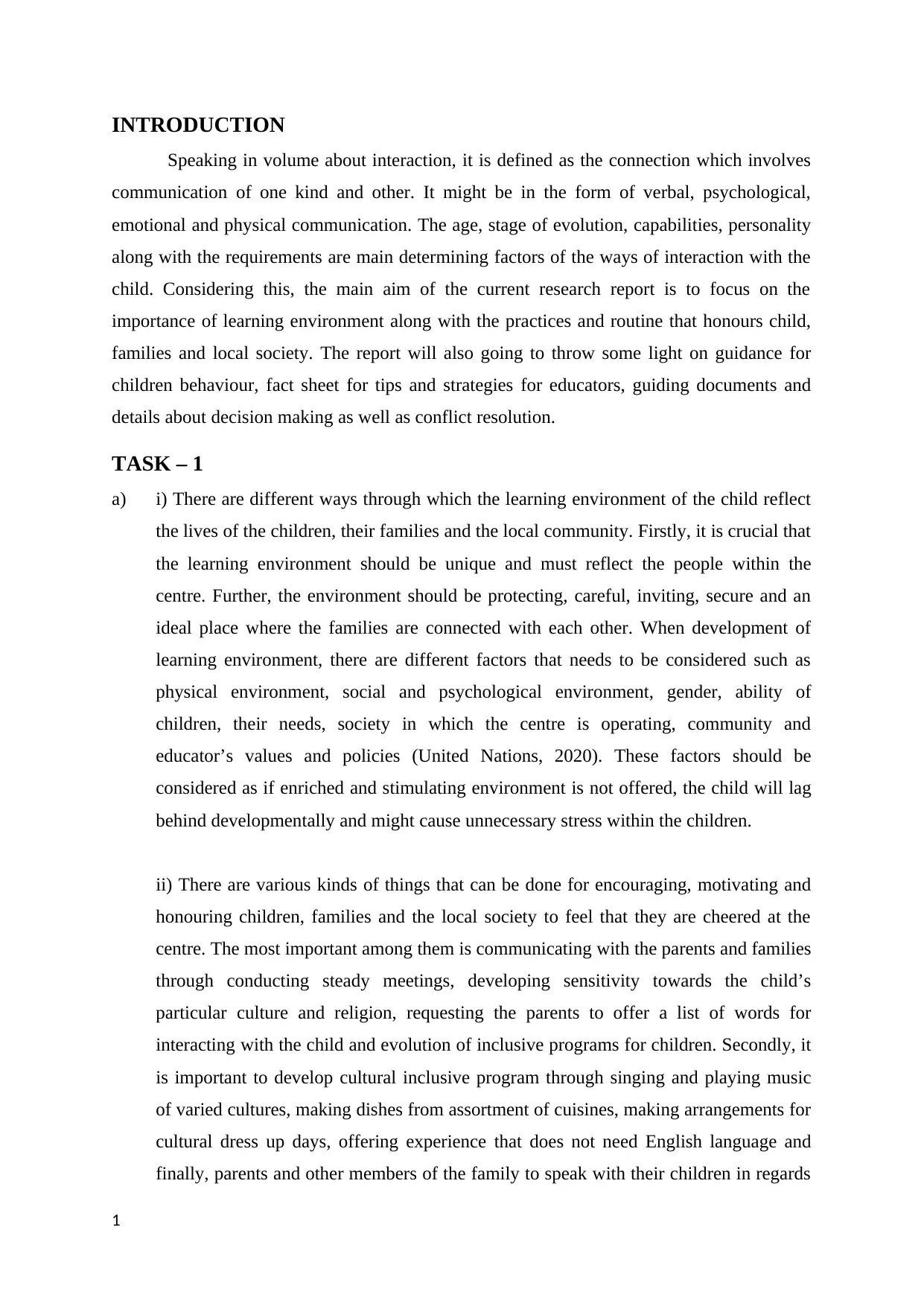
INTRODUCTION
Speaking in volume about interaction, it is defined as the connection which involves
communication of one kind and other. It might be in the form of verbal, psychological,
emotional and physical communication. The age, stage of evolution, capabilities, personality
along with the requirements are main determining factors of the ways of interaction with the
child. Considering this, the main aim of the current research report is to focus on the
importance of learning environment along with the practices and routine that honours child,
families and local society. The report will also going to throw some light on guidance for
children behaviour, fact sheet for tips and strategies for educators, guiding documents and
details about decision making as well as conflict resolution.
TASK – 1
a) i) There are different ways through which the learning environment of the child reflect
the lives of the children, their families and the local community. Firstly, it is crucial that
the learning environment should be unique and must reflect the people within the
centre. Further, the environment should be protecting, careful, inviting, secure and an
ideal place where the families are connected with each other. When development of
learning environment, there are different factors that needs to be considered such as
physical environment, social and psychological environment, gender, ability of
children, their needs, society in which the centre is operating, community and
educator’s values and policies (United Nations, 2020). These factors should be
considered as if enriched and stimulating environment is not offered, the child will lag
behind developmentally and might cause unnecessary stress within the children.
ii) There are various kinds of things that can be done for encouraging, motivating and
honouring children, families and the local society to feel that they are cheered at the
centre. The most important among them is communicating with the parents and families
through conducting steady meetings, developing sensitivity towards the child’s
particular culture and religion, requesting the parents to offer a list of words for
interacting with the child and evolution of inclusive programs for children. Secondly, it
is important to develop cultural inclusive program through singing and playing music
of varied cultures, making dishes from assortment of cuisines, making arrangements for
cultural dress up days, offering experience that does not need English language and
finally, parents and other members of the family to speak with their children in regards
1
Speaking in volume about interaction, it is defined as the connection which involves
communication of one kind and other. It might be in the form of verbal, psychological,
emotional and physical communication. The age, stage of evolution, capabilities, personality
along with the requirements are main determining factors of the ways of interaction with the
child. Considering this, the main aim of the current research report is to focus on the
importance of learning environment along with the practices and routine that honours child,
families and local society. The report will also going to throw some light on guidance for
children behaviour, fact sheet for tips and strategies for educators, guiding documents and
details about decision making as well as conflict resolution.
TASK – 1
a) i) There are different ways through which the learning environment of the child reflect
the lives of the children, their families and the local community. Firstly, it is crucial that
the learning environment should be unique and must reflect the people within the
centre. Further, the environment should be protecting, careful, inviting, secure and an
ideal place where the families are connected with each other. When development of
learning environment, there are different factors that needs to be considered such as
physical environment, social and psychological environment, gender, ability of
children, their needs, society in which the centre is operating, community and
educator’s values and policies (United Nations, 2020). These factors should be
considered as if enriched and stimulating environment is not offered, the child will lag
behind developmentally and might cause unnecessary stress within the children.
ii) There are various kinds of things that can be done for encouraging, motivating and
honouring children, families and the local society to feel that they are cheered at the
centre. The most important among them is communicating with the parents and families
through conducting steady meetings, developing sensitivity towards the child’s
particular culture and religion, requesting the parents to offer a list of words for
interacting with the child and evolution of inclusive programs for children. Secondly, it
is important to develop cultural inclusive program through singing and playing music
of varied cultures, making dishes from assortment of cuisines, making arrangements for
cultural dress up days, offering experience that does not need English language and
finally, parents and other members of the family to speak with their children in regards
1
⊘ This is a preview!⊘
Do you want full access?
Subscribe today to unlock all pages.

Trusted by 1+ million students worldwide
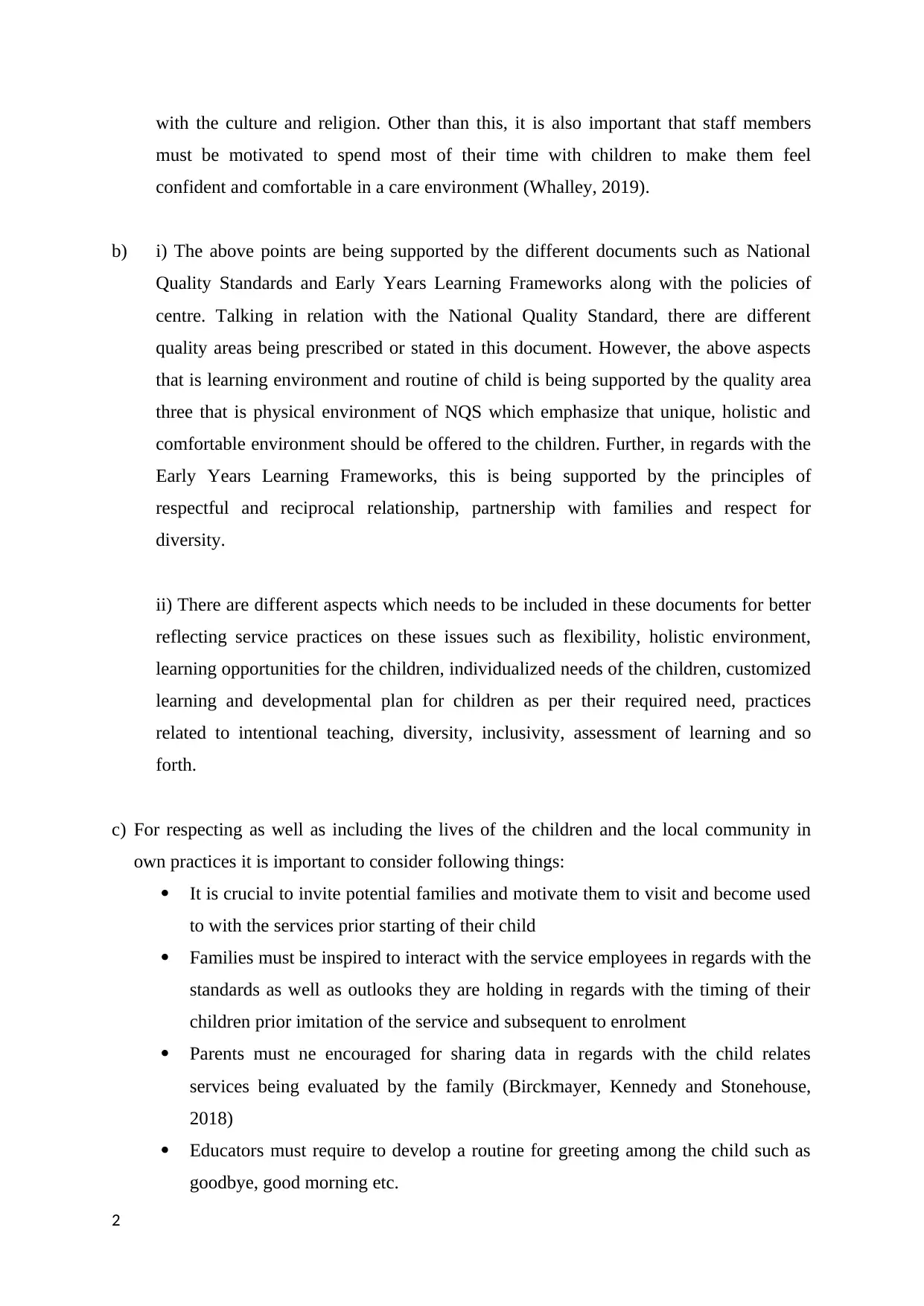
with the culture and religion. Other than this, it is also important that staff members
must be motivated to spend most of their time with children to make them feel
confident and comfortable in a care environment (Whalley, 2019).
b) i) The above points are being supported by the different documents such as National
Quality Standards and Early Years Learning Frameworks along with the policies of
centre. Talking in relation with the National Quality Standard, there are different
quality areas being prescribed or stated in this document. However, the above aspects
that is learning environment and routine of child is being supported by the quality area
three that is physical environment of NQS which emphasize that unique, holistic and
comfortable environment should be offered to the children. Further, in regards with the
Early Years Learning Frameworks, this is being supported by the principles of
respectful and reciprocal relationship, partnership with families and respect for
diversity.
ii) There are different aspects which needs to be included in these documents for better
reflecting service practices on these issues such as flexibility, holistic environment,
learning opportunities for the children, individualized needs of the children, customized
learning and developmental plan for children as per their required need, practices
related to intentional teaching, diversity, inclusivity, assessment of learning and so
forth.
c) For respecting as well as including the lives of the children and the local community in
own practices it is important to consider following things:
It is crucial to invite potential families and motivate them to visit and become used
to with the services prior starting of their child
Families must be inspired to interact with the service employees in regards with the
standards as well as outlooks they are holding in regards with the timing of their
children prior imitation of the service and subsequent to enrolment
Parents must ne encouraged for sharing data in regards with the child relates
services being evaluated by the family (Birckmayer, Kennedy and Stonehouse,
2018)
Educators must require to develop a routine for greeting among the child such as
goodbye, good morning etc.
2
must be motivated to spend most of their time with children to make them feel
confident and comfortable in a care environment (Whalley, 2019).
b) i) The above points are being supported by the different documents such as National
Quality Standards and Early Years Learning Frameworks along with the policies of
centre. Talking in relation with the National Quality Standard, there are different
quality areas being prescribed or stated in this document. However, the above aspects
that is learning environment and routine of child is being supported by the quality area
three that is physical environment of NQS which emphasize that unique, holistic and
comfortable environment should be offered to the children. Further, in regards with the
Early Years Learning Frameworks, this is being supported by the principles of
respectful and reciprocal relationship, partnership with families and respect for
diversity.
ii) There are different aspects which needs to be included in these documents for better
reflecting service practices on these issues such as flexibility, holistic environment,
learning opportunities for the children, individualized needs of the children, customized
learning and developmental plan for children as per their required need, practices
related to intentional teaching, diversity, inclusivity, assessment of learning and so
forth.
c) For respecting as well as including the lives of the children and the local community in
own practices it is important to consider following things:
It is crucial to invite potential families and motivate them to visit and become used
to with the services prior starting of their child
Families must be inspired to interact with the service employees in regards with the
standards as well as outlooks they are holding in regards with the timing of their
children prior imitation of the service and subsequent to enrolment
Parents must ne encouraged for sharing data in regards with the child relates
services being evaluated by the family (Birckmayer, Kennedy and Stonehouse,
2018)
Educators must require to develop a routine for greeting among the child such as
goodbye, good morning etc.
2
Paraphrase This Document
Need a fresh take? Get an instant paraphrase of this document with our AI Paraphraser
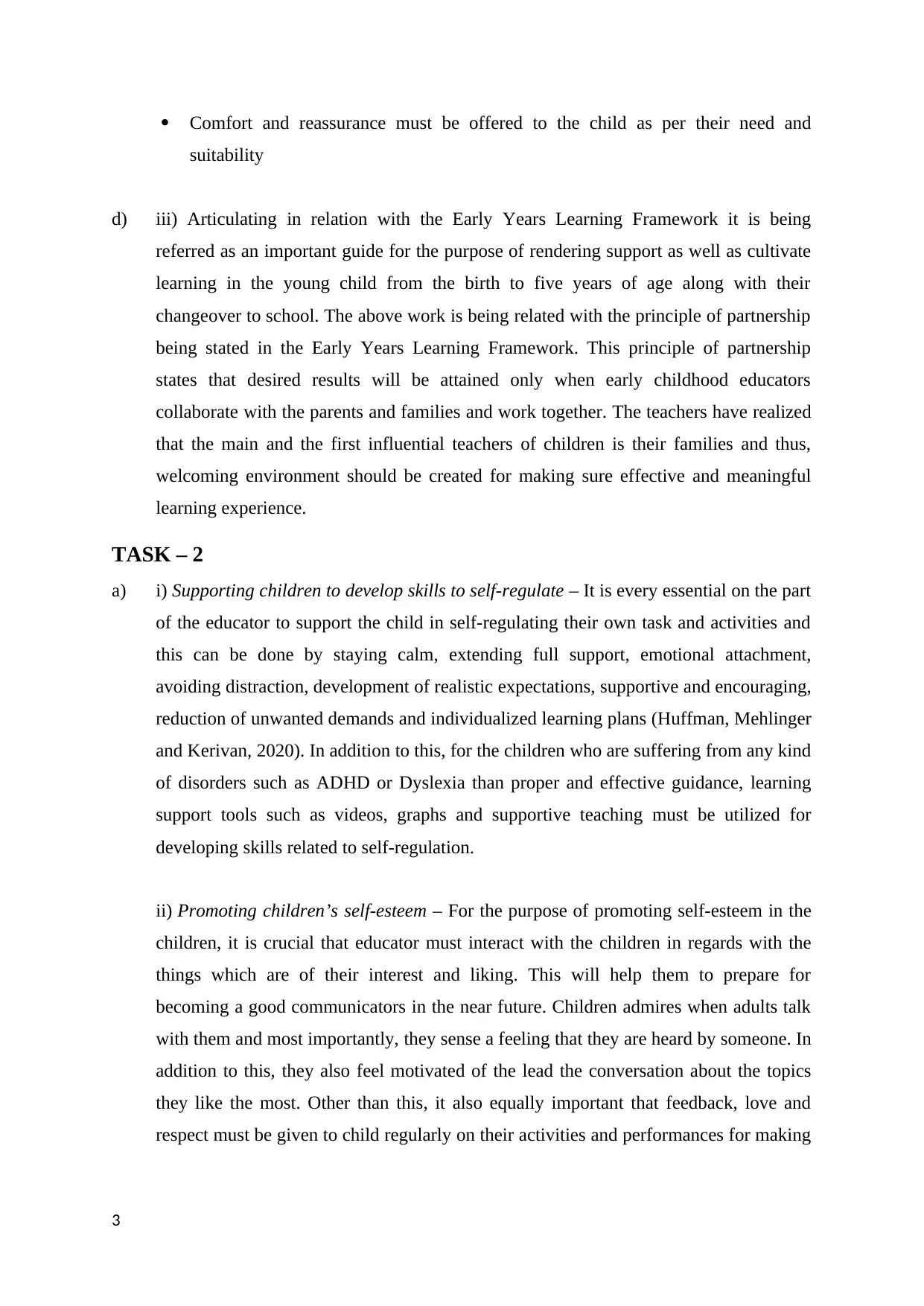
Comfort and reassurance must be offered to the child as per their need and
suitability
d) iii) Articulating in relation with the Early Years Learning Framework it is being
referred as an important guide for the purpose of rendering support as well as cultivate
learning in the young child from the birth to five years of age along with their
changeover to school. The above work is being related with the principle of partnership
being stated in the Early Years Learning Framework. This principle of partnership
states that desired results will be attained only when early childhood educators
collaborate with the parents and families and work together. The teachers have realized
that the main and the first influential teachers of children is their families and thus,
welcoming environment should be created for making sure effective and meaningful
learning experience.
TASK – 2
a) i) Supporting children to develop skills to self-regulate – It is every essential on the part
of the educator to support the child in self-regulating their own task and activities and
this can be done by staying calm, extending full support, emotional attachment,
avoiding distraction, development of realistic expectations, supportive and encouraging,
reduction of unwanted demands and individualized learning plans (Huffman, Mehlinger
and Kerivan, 2020). In addition to this, for the children who are suffering from any kind
of disorders such as ADHD or Dyslexia than proper and effective guidance, learning
support tools such as videos, graphs and supportive teaching must be utilized for
developing skills related to self-regulation.
ii) Promoting children’s self-esteem – For the purpose of promoting self-esteem in the
children, it is crucial that educator must interact with the children in regards with the
things which are of their interest and liking. This will help them to prepare for
becoming a good communicators in the near future. Children admires when adults talk
with them and most importantly, they sense a feeling that they are heard by someone. In
addition to this, they also feel motivated of the lead the conversation about the topics
they like the most. Other than this, it also equally important that feedback, love and
respect must be given to child regularly on their activities and performances for making
3
suitability
d) iii) Articulating in relation with the Early Years Learning Framework it is being
referred as an important guide for the purpose of rendering support as well as cultivate
learning in the young child from the birth to five years of age along with their
changeover to school. The above work is being related with the principle of partnership
being stated in the Early Years Learning Framework. This principle of partnership
states that desired results will be attained only when early childhood educators
collaborate with the parents and families and work together. The teachers have realized
that the main and the first influential teachers of children is their families and thus,
welcoming environment should be created for making sure effective and meaningful
learning experience.
TASK – 2
a) i) Supporting children to develop skills to self-regulate – It is every essential on the part
of the educator to support the child in self-regulating their own task and activities and
this can be done by staying calm, extending full support, emotional attachment,
avoiding distraction, development of realistic expectations, supportive and encouraging,
reduction of unwanted demands and individualized learning plans (Huffman, Mehlinger
and Kerivan, 2020). In addition to this, for the children who are suffering from any kind
of disorders such as ADHD or Dyslexia than proper and effective guidance, learning
support tools such as videos, graphs and supportive teaching must be utilized for
developing skills related to self-regulation.
ii) Promoting children’s self-esteem – For the purpose of promoting self-esteem in the
children, it is crucial that educator must interact with the children in regards with the
things which are of their interest and liking. This will help them to prepare for
becoming a good communicators in the near future. Children admires when adults talk
with them and most importantly, they sense a feeling that they are heard by someone. In
addition to this, they also feel motivated of the lead the conversation about the topics
they like the most. Other than this, it also equally important that feedback, love and
respect must be given to child regularly on their activities and performances for making
3
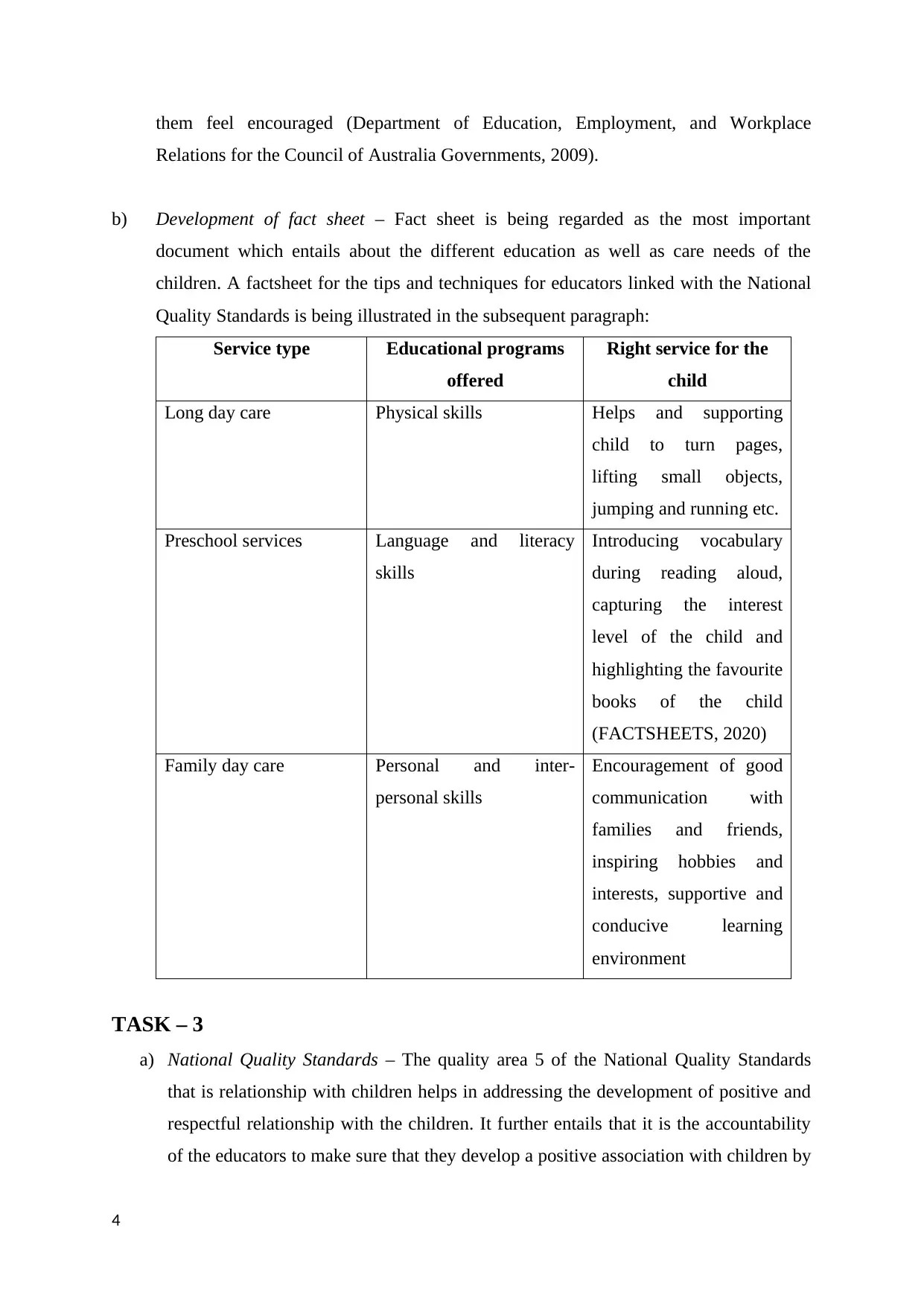
them feel encouraged (Department of Education, Employment, and Workplace
Relations for the Council of Australia Governments, 2009).
b) Development of fact sheet – Fact sheet is being regarded as the most important
document which entails about the different education as well as care needs of the
children. A factsheet for the tips and techniques for educators linked with the National
Quality Standards is being illustrated in the subsequent paragraph:
Service type Educational programs
offered
Right service for the
child
Long day care Physical skills Helps and supporting
child to turn pages,
lifting small objects,
jumping and running etc.
Preschool services Language and literacy
skills
Introducing vocabulary
during reading aloud,
capturing the interest
level of the child and
highlighting the favourite
books of the child
(FACTSHEETS, 2020)
Family day care Personal and inter-
personal skills
Encouragement of good
communication with
families and friends,
inspiring hobbies and
interests, supportive and
conducive learning
environment
TASK – 3
a) National Quality Standards – The quality area 5 of the National Quality Standards
that is relationship with children helps in addressing the development of positive and
respectful relationship with the children. It further entails that it is the accountability
of the educators to make sure that they develop a positive association with children by
4
Relations for the Council of Australia Governments, 2009).
b) Development of fact sheet – Fact sheet is being regarded as the most important
document which entails about the different education as well as care needs of the
children. A factsheet for the tips and techniques for educators linked with the National
Quality Standards is being illustrated in the subsequent paragraph:
Service type Educational programs
offered
Right service for the
child
Long day care Physical skills Helps and supporting
child to turn pages,
lifting small objects,
jumping and running etc.
Preschool services Language and literacy
skills
Introducing vocabulary
during reading aloud,
capturing the interest
level of the child and
highlighting the favourite
books of the child
(FACTSHEETS, 2020)
Family day care Personal and inter-
personal skills
Encouragement of good
communication with
families and friends,
inspiring hobbies and
interests, supportive and
conducive learning
environment
TASK – 3
a) National Quality Standards – The quality area 5 of the National Quality Standards
that is relationship with children helps in addressing the development of positive and
respectful relationship with the children. It further entails that it is the accountability
of the educators to make sure that they develop a positive association with children by
4
⊘ This is a preview!⊘
Do you want full access?
Subscribe today to unlock all pages.

Trusted by 1+ million students worldwide
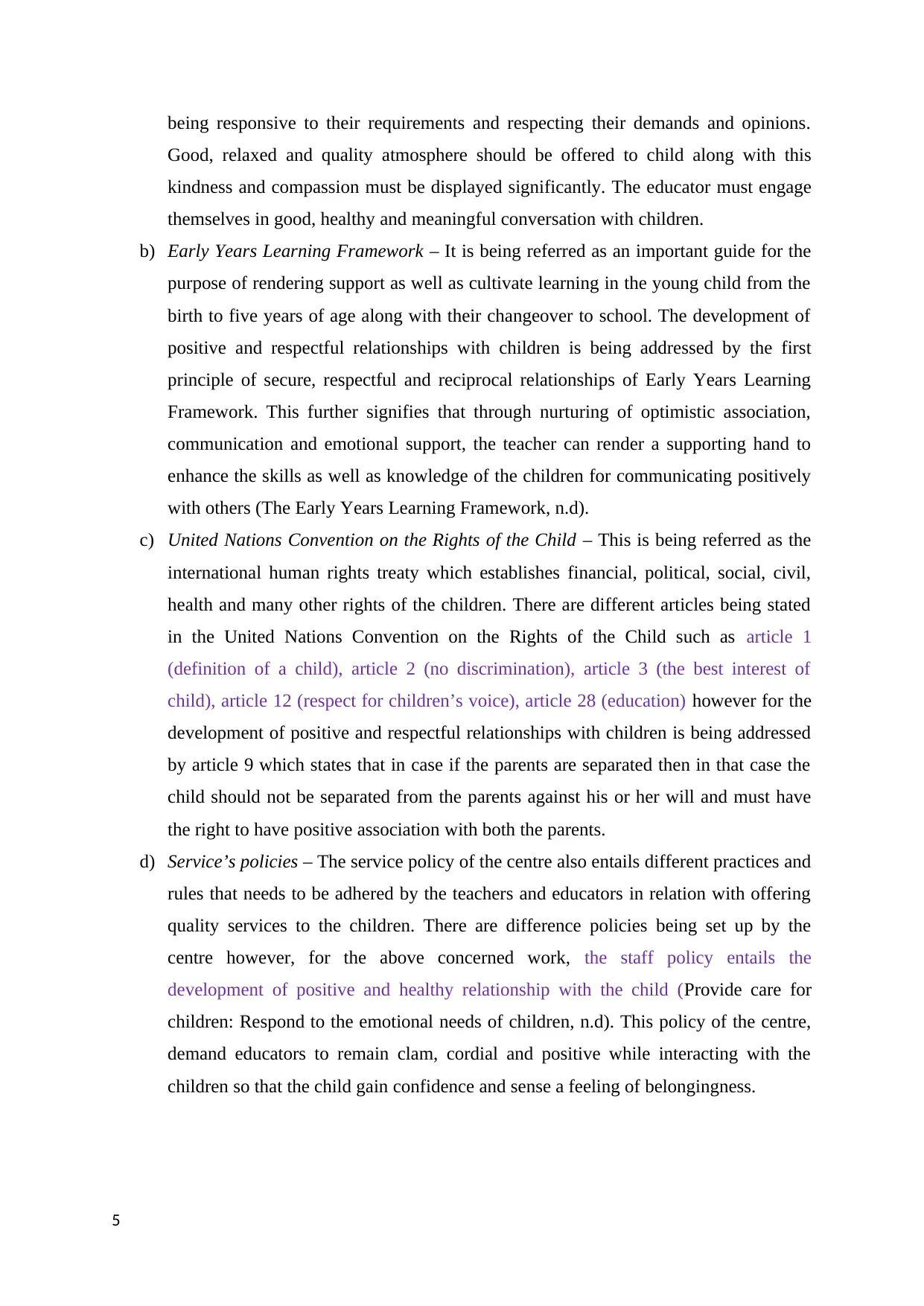
being responsive to their requirements and respecting their demands and opinions.
Good, relaxed and quality atmosphere should be offered to child along with this
kindness and compassion must be displayed significantly. The educator must engage
themselves in good, healthy and meaningful conversation with children.
b) Early Years Learning Framework – It is being referred as an important guide for the
purpose of rendering support as well as cultivate learning in the young child from the
birth to five years of age along with their changeover to school. The development of
positive and respectful relationships with children is being addressed by the first
principle of secure, respectful and reciprocal relationships of Early Years Learning
Framework. This further signifies that through nurturing of optimistic association,
communication and emotional support, the teacher can render a supporting hand to
enhance the skills as well as knowledge of the children for communicating positively
with others (The Early Years Learning Framework, n.d).
c) United Nations Convention on the Rights of the Child – This is being referred as the
international human rights treaty which establishes financial, political, social, civil,
health and many other rights of the children. There are different articles being stated
in the United Nations Convention on the Rights of the Child such as article 1
(definition of a child), article 2 (no discrimination), article 3 (the best interest of
child), article 12 (respect for children’s voice), article 28 (education) however for the
development of positive and respectful relationships with children is being addressed
by article 9 which states that in case if the parents are separated then in that case the
child should not be separated from the parents against his or her will and must have
the right to have positive association with both the parents.
d) Service’s policies – The service policy of the centre also entails different practices and
rules that needs to be adhered by the teachers and educators in relation with offering
quality services to the children. There are difference policies being set up by the
centre however, for the above concerned work, the staff policy entails the
development of positive and healthy relationship with the child (Provide care for
children: Respond to the emotional needs of children, n.d). This policy of the centre,
demand educators to remain clam, cordial and positive while interacting with the
children so that the child gain confidence and sense a feeling of belongingness.
5
Good, relaxed and quality atmosphere should be offered to child along with this
kindness and compassion must be displayed significantly. The educator must engage
themselves in good, healthy and meaningful conversation with children.
b) Early Years Learning Framework – It is being referred as an important guide for the
purpose of rendering support as well as cultivate learning in the young child from the
birth to five years of age along with their changeover to school. The development of
positive and respectful relationships with children is being addressed by the first
principle of secure, respectful and reciprocal relationships of Early Years Learning
Framework. This further signifies that through nurturing of optimistic association,
communication and emotional support, the teacher can render a supporting hand to
enhance the skills as well as knowledge of the children for communicating positively
with others (The Early Years Learning Framework, n.d).
c) United Nations Convention on the Rights of the Child – This is being referred as the
international human rights treaty which establishes financial, political, social, civil,
health and many other rights of the children. There are different articles being stated
in the United Nations Convention on the Rights of the Child such as article 1
(definition of a child), article 2 (no discrimination), article 3 (the best interest of
child), article 12 (respect for children’s voice), article 28 (education) however for the
development of positive and respectful relationships with children is being addressed
by article 9 which states that in case if the parents are separated then in that case the
child should not be separated from the parents against his or her will and must have
the right to have positive association with both the parents.
d) Service’s policies – The service policy of the centre also entails different practices and
rules that needs to be adhered by the teachers and educators in relation with offering
quality services to the children. There are difference policies being set up by the
centre however, for the above concerned work, the staff policy entails the
development of positive and healthy relationship with the child (Provide care for
children: Respond to the emotional needs of children, n.d). This policy of the centre,
demand educators to remain clam, cordial and positive while interacting with the
children so that the child gain confidence and sense a feeling of belongingness.
5
Paraphrase This Document
Need a fresh take? Get an instant paraphrase of this document with our AI Paraphraser
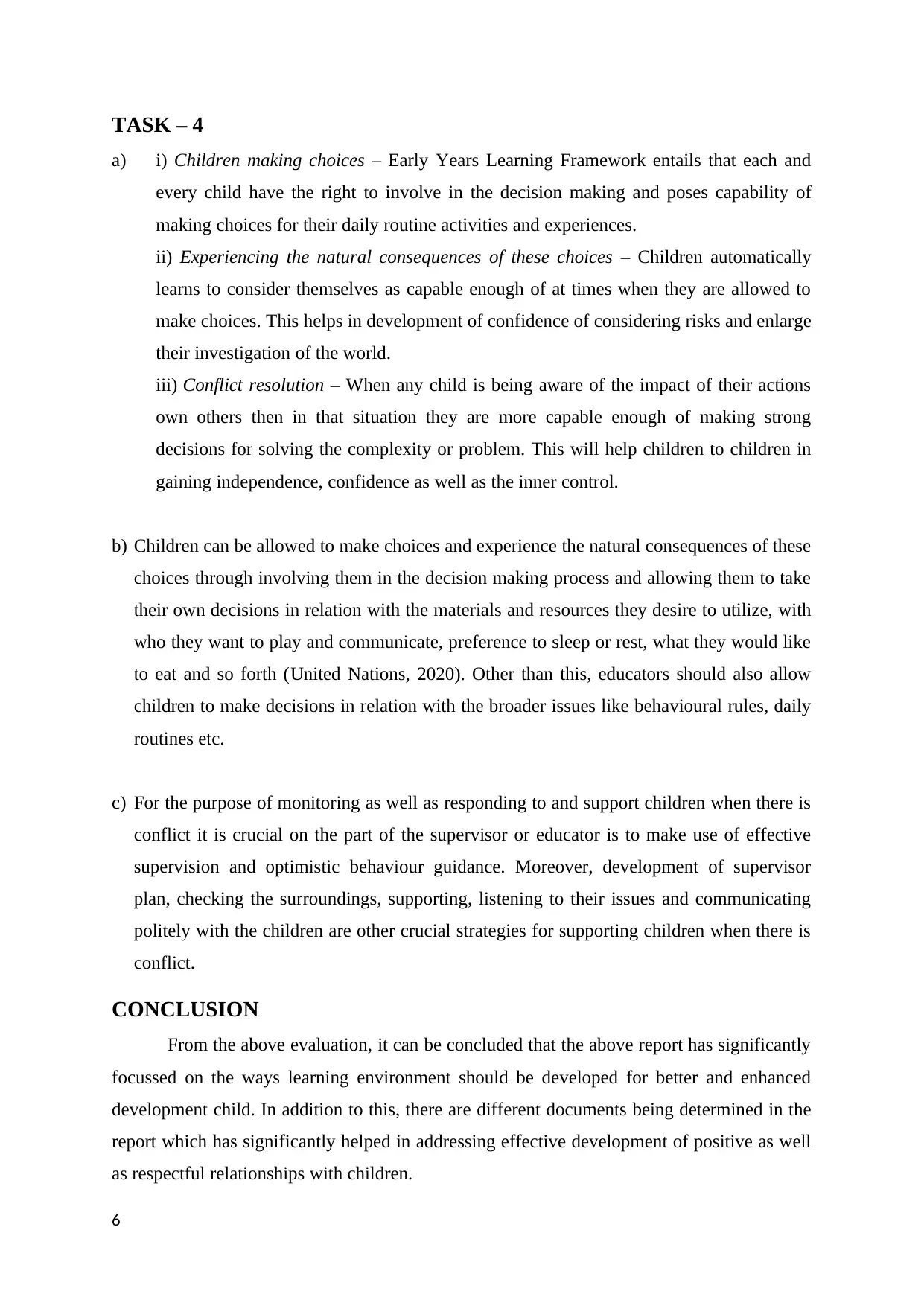
TASK – 4
a) i) Children making choices – Early Years Learning Framework entails that each and
every child have the right to involve in the decision making and poses capability of
making choices for their daily routine activities and experiences.
ii) Experiencing the natural consequences of these choices – Children automatically
learns to consider themselves as capable enough of at times when they are allowed to
make choices. This helps in development of confidence of considering risks and enlarge
their investigation of the world.
iii) Conflict resolution – When any child is being aware of the impact of their actions
own others then in that situation they are more capable enough of making strong
decisions for solving the complexity or problem. This will help children to children in
gaining independence, confidence as well as the inner control.
b) Children can be allowed to make choices and experience the natural consequences of these
choices through involving them in the decision making process and allowing them to take
their own decisions in relation with the materials and resources they desire to utilize, with
who they want to play and communicate, preference to sleep or rest, what they would like
to eat and so forth (United Nations, 2020). Other than this, educators should also allow
children to make decisions in relation with the broader issues like behavioural rules, daily
routines etc.
c) For the purpose of monitoring as well as responding to and support children when there is
conflict it is crucial on the part of the supervisor or educator is to make use of effective
supervision and optimistic behaviour guidance. Moreover, development of supervisor
plan, checking the surroundings, supporting, listening to their issues and communicating
politely with the children are other crucial strategies for supporting children when there is
conflict.
CONCLUSION
From the above evaluation, it can be concluded that the above report has significantly
focussed on the ways learning environment should be developed for better and enhanced
development child. In addition to this, there are different documents being determined in the
report which has significantly helped in addressing effective development of positive as well
as respectful relationships with children.
6
a) i) Children making choices – Early Years Learning Framework entails that each and
every child have the right to involve in the decision making and poses capability of
making choices for their daily routine activities and experiences.
ii) Experiencing the natural consequences of these choices – Children automatically
learns to consider themselves as capable enough of at times when they are allowed to
make choices. This helps in development of confidence of considering risks and enlarge
their investigation of the world.
iii) Conflict resolution – When any child is being aware of the impact of their actions
own others then in that situation they are more capable enough of making strong
decisions for solving the complexity or problem. This will help children to children in
gaining independence, confidence as well as the inner control.
b) Children can be allowed to make choices and experience the natural consequences of these
choices through involving them in the decision making process and allowing them to take
their own decisions in relation with the materials and resources they desire to utilize, with
who they want to play and communicate, preference to sleep or rest, what they would like
to eat and so forth (United Nations, 2020). Other than this, educators should also allow
children to make decisions in relation with the broader issues like behavioural rules, daily
routines etc.
c) For the purpose of monitoring as well as responding to and support children when there is
conflict it is crucial on the part of the supervisor or educator is to make use of effective
supervision and optimistic behaviour guidance. Moreover, development of supervisor
plan, checking the surroundings, supporting, listening to their issues and communicating
politely with the children are other crucial strategies for supporting children when there is
conflict.
CONCLUSION
From the above evaluation, it can be concluded that the above report has significantly
focussed on the ways learning environment should be developed for better and enhanced
development child. In addition to this, there are different documents being determined in the
report which has significantly helped in addressing effective development of positive as well
as respectful relationships with children.
6
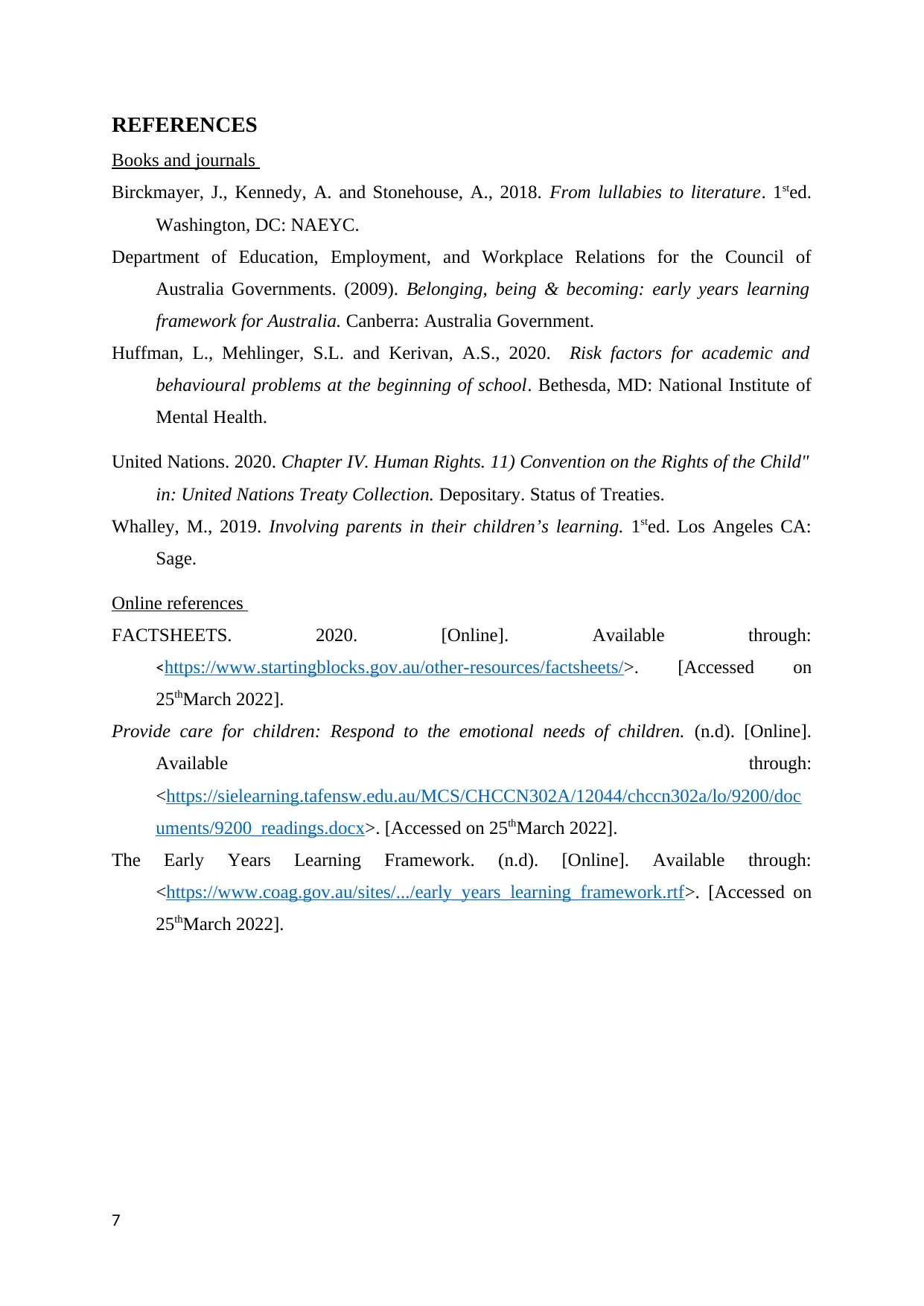
REFERENCES
Books and journals
Birckmayer, J., Kennedy, A. and Stonehouse, A., 2018. From lullabies to literature. 1sted.
Washington, DC: NAEYC.
Department of Education, Employment, and Workplace Relations for the Council of
Australia Governments. (2009). Belonging, being & becoming: early years learning
framework for Australia. Canberra: Australia Government.
Huffman, L., Mehlinger, S.L. and Kerivan, A.S., 2020. Risk factors for academic and
behavioural problems at the beginning of school. Bethesda, MD: National Institute of
Mental Health.
United Nations. 2020. Chapter IV. Human Rights. 11) Convention on the Rights of the Child"
in: United Nations Treaty Collection. Depositary. Status of Treaties.
Whalley, M., 2019. Involving parents in their children’s learning. 1sted. Los Angeles CA:
Sage.
Online references
FACTSHEETS. 2020. [Online]. Available through:
<https://www.startingblocks.gov.au/other-resources/factsheets/>. [Accessed on
25thMarch 2022].
Provide care for children: Respond to the emotional needs of children. (n.d). [Online].
Available through:
<https://sielearning.tafensw.edu.au/MCS/CHCCN302A/12044/chccn302a/lo/9200/doc
uments/9200_readings.docx>. [Accessed on 25thMarch 2022].
The Early Years Learning Framework. (n.d). [Online]. Available through:
<https://www.coag.gov.au/sites/.../early_years_learning_framework.rtf>. [Accessed on
25thMarch 2022].
7
Books and journals
Birckmayer, J., Kennedy, A. and Stonehouse, A., 2018. From lullabies to literature. 1sted.
Washington, DC: NAEYC.
Department of Education, Employment, and Workplace Relations for the Council of
Australia Governments. (2009). Belonging, being & becoming: early years learning
framework for Australia. Canberra: Australia Government.
Huffman, L., Mehlinger, S.L. and Kerivan, A.S., 2020. Risk factors for academic and
behavioural problems at the beginning of school. Bethesda, MD: National Institute of
Mental Health.
United Nations. 2020. Chapter IV. Human Rights. 11) Convention on the Rights of the Child"
in: United Nations Treaty Collection. Depositary. Status of Treaties.
Whalley, M., 2019. Involving parents in their children’s learning. 1sted. Los Angeles CA:
Sage.
Online references
FACTSHEETS. 2020. [Online]. Available through:
<https://www.startingblocks.gov.au/other-resources/factsheets/>. [Accessed on
25thMarch 2022].
Provide care for children: Respond to the emotional needs of children. (n.d). [Online].
Available through:
<https://sielearning.tafensw.edu.au/MCS/CHCCN302A/12044/chccn302a/lo/9200/doc
uments/9200_readings.docx>. [Accessed on 25thMarch 2022].
The Early Years Learning Framework. (n.d). [Online]. Available through:
<https://www.coag.gov.au/sites/.../early_years_learning_framework.rtf>. [Accessed on
25thMarch 2022].
7
⊘ This is a preview!⊘
Do you want full access?
Subscribe today to unlock all pages.

Trusted by 1+ million students worldwide
1 out of 9
Related Documents
Your All-in-One AI-Powered Toolkit for Academic Success.
+13062052269
info@desklib.com
Available 24*7 on WhatsApp / Email
![[object Object]](/_next/static/media/star-bottom.7253800d.svg)
Unlock your academic potential
Copyright © 2020–2025 A2Z Services. All Rights Reserved. Developed and managed by ZUCOL.





